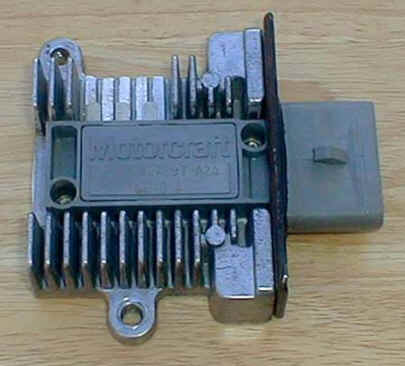</ramble on>
Let's try this again. Here's a link to a ~2003 Bosch ignition modules doc:
www.pim-engineering.com/tiedostot/ignitionmodules.pdf
My read of this [aka good guess] is that there were 3 types of ignition modules at the time (ignoring the number channels):
1) Inductive Trigger (aka +/- AC sine wave) with dwell control
2a) Hall Trigger (aka + DC squarewave) with dwell control, shared sensor and coil power
2b) Hall Trigger (aka + DC squarewave) with dwell control, separate sensor and coil power
3) ECU Trigger (aka + DC squarewave), no dwell control
An Inductive Trigger, or VR trigger, generates a + or - voltage pulse at each edge of the distributor flag/tooth. The pulses are roughly half sinewave in shape. For discussion, say that a positive voltage pulse is generated at the beginning of the distributor flag, and a negative voltage pulse at the end of the flag.
A Hall Trigger generates a + voltage square wave. For discussion, say that it's ~0volts when the flag is not in front of the sensor, and ~11volts, or maybe 5volts, when the flag is in front of the sensor.
If you sketch out the Trigger signals, or view them on an oscilloscope, you'll see that they're much different. You need to match the type of the module to your trigger signal - Hall&DC or Inductive&AC. Do you know what your trigger signal looks like?
For modules with dwell control, the positive pulse or rising edge of the trigger signal starts to charge the coil. The dwell control circuits may delay charging from this starting pulse/edge as needed. The negative pulse or falling edge of the trigger signal then fires the spark.
If you understand this so far, you'll realize that a Hall module with dwell control can also be used with an ECU that controls dwell. In this case, the module starts to charge immediately without any delay on the rising ECU signal. An inductive AC trigger module won't work due to the DC/square wave from the ECU.
The next issue is what the ECU spark signal looks like when using multiple coils. If the positive pulse width stays the same, but the low time ~doubles, then modules with dwell control should work fine. The time the module needs to delay before starting to charge the coil stays the same.
If the pulse width doubles when changing to multi-coil mode, then modules with dwell control may have problems at low speeds. In this case, the time the module needs to delay before starting to charge the coil becomes much longer.
Do you know what the spark output from your ECU looks like in single coil mode and what it looks like in multi-coil mode? Does the ECU allow any configuration of the spark outputs other than number of coils?
-Bob
</ramble off>






